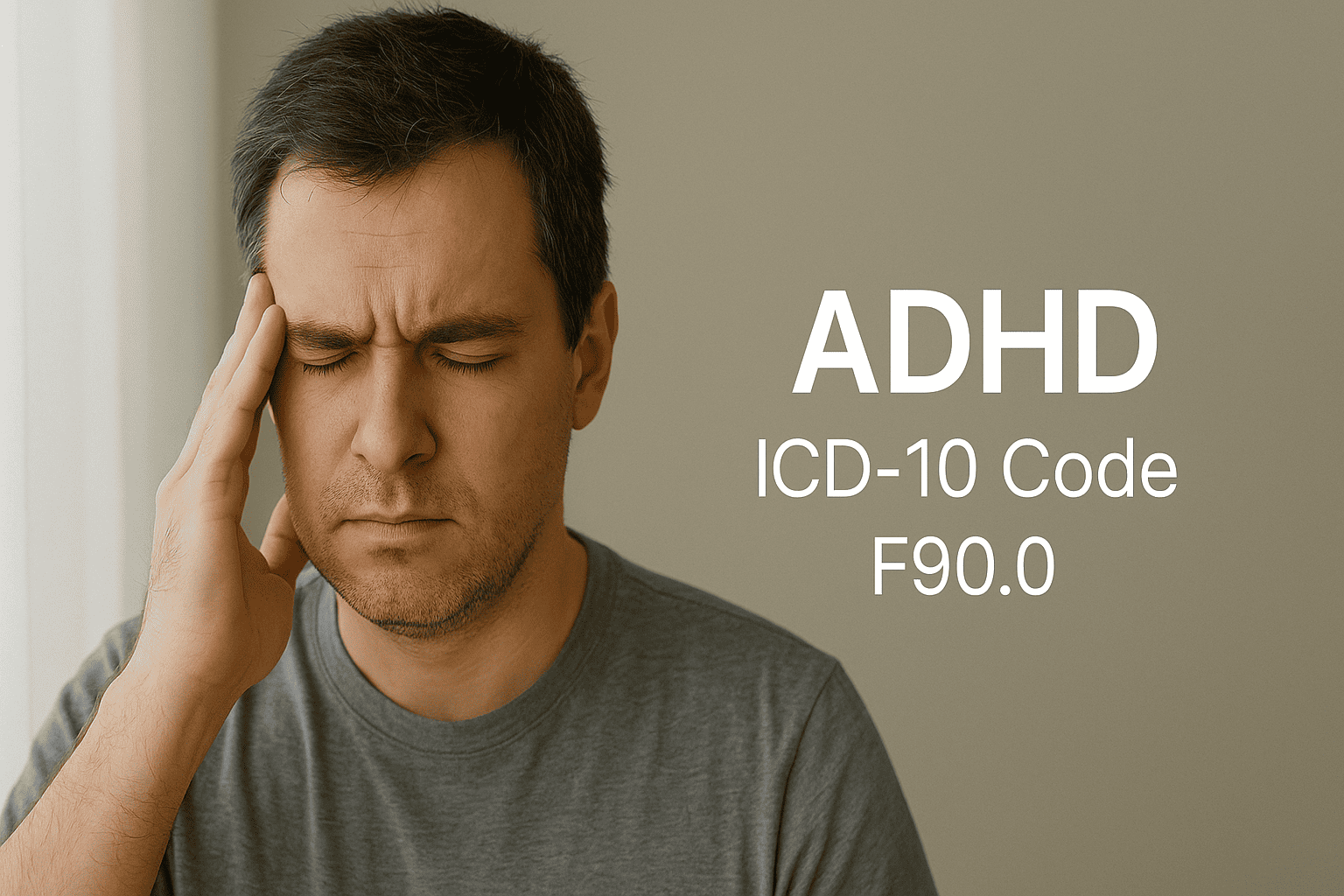Updated on: July 25, 2025
Attention-Deficit Hyperactivity Disorder (ADHD) is a neurodevelopmental condition that affects focus, impulse control, and executive function. The inattentive type, coded as F90.0, is characterized by significant difficulty sustaining attention, disorganization, and forgetfulness, with minimal or no hyperactivity. This presentation is often underdiagnosed—especially in girls and adults—as it lacks the disruptive behaviors seen in hyperactive subtypes.
ICD-10 Code F90.0: Explained
-
F90 = ADHD and other attention disorders
-
.0 = Predominantly inattentive type
Use F90.0 when:
-
ADHD is confirmed by a clinician using DSM-5 criteria
-
The patient primarily shows inattention symptoms, not hyperactivity or impulsivity
-
Symptoms have been present for ≥6 months
-
Functional impairment is documented (e.g., in school, work, relationships)
Other ADHD ICD-10 Codes for Comparison
| ICD-10 Code | Description |
|---|---|
| F90.0 | ADHD, predominantly inattentive type |
| F90.1 | ADHD, predominantly hyperactive-impulsive type |
| F90.2 | ADHD, combined type |
| F90.9 | ADHD, unspecified type |
🎯 Specific coding helps tailor treatment plans and improve payer compliance.
DSM-5 Criteria for Inattentive ADHD
Diagnosis requires ≥6 symptoms (≥5 for adults), persisting for ≥6 months, including:
-
Fails to give close attention to details
-
Difficulty sustaining attention
-
Doesn’t seem to listen
-
Struggles to follow instructions
-
Poor organization
-
Avoids tasks requiring mental effort
-
Often loses items
-
Easily distracted
-
Forgetful in daily activities
Sample Clinical Documentation for F90.0
“Patient exhibits chronic difficulties maintaining attention during tasks, forgets assignments, and frequently loses personal items. Symptoms noted at home and in school for over 9 months. No significant hyperactivity reported. Meets DSM-5 criteria for ADHD – inattentive type (F90.0).”
ADHD Evaluation & Treatment Workflow
-
Screening tools: Vanderbilt Assessment, Conners Scale
-
Clinical Interview: Assess symptom onset, duration, settings
-
Diagnosis: Rule out anxiety, learning disabilities, mood disorders
-
Treatment:
-
Behavioral therapy (first-line in young children)
-
Stimulants (e.g., methylphenidate, amphetamines)
-
Non-stimulants (e.g., atomoxetine, guanfacine)
-
-
Follow-up: Track side effects, school reports, response to meds
DocScrib captures these steps and integrates ADHD templates seamlessly into your EHR notes.
Commonly Paired ICD-10 Codes
| Condition / Context | ICD-10 Code |
|---|---|
| ADHD, inattentive type | F90.0 |
| Learning disabilities (reading/math) | F81.0–F81.2 |
| Anxiety disorder (comorbid) | F41.1 |
| Conduct disorder or ODD | F91.3 |
| Developmental coordination disorder | F82 |
| Long-term stimulant use | Z79.899 |
| Educational difficulties | Z55.9 |
📌 Comorbidities are common—accurate coding supports full clinical picture and billing.
Key Documentation Tips for F90.0
To ensure coding compliance and clinical clarity:
-
State ADHD type explicitly (inattentive, not combined or unspecified)
-
Include DSM-5 criteria and age of onset
-
Confirm functional impact in at least 2 settings (home, school, work)
-
Note prior interventions, therapies, or medication trials
🧠 Always document progress over time to support continued treatment or medication management.
DocScrib’s Role in ADHD Documentation
For busy pediatricians and psychiatrists, DocScrib’s AI scribe:
-
Captures diagnostic interview details in real time
-
Flags missing DSM-5 elements for ADHD
-
Automatically pulls in Vanderbilt scores
-
Suggests correct F90.x code based on notes
-
Supports school communication forms and refill workflows
👉 See how DocScrib improves ADHD documentation →
Coding, Reimbursement & Educational Support
-
F90.0 supports behavioral therapy, academic accommodations, and medication
-
Allows eligibility for 504 Plans, IEPs, or therapy reimbursement
-
Avoids vague coding (e.g., F90.9) that could cause delays in payer approval or education services
✅ Many insurers and schools require specific ADHD subtype codes for treatment or accommodation requests.
Frequently Asked Questions
Can F90.0 be used in adults?
Yes. Adults must show ≥5 symptoms of inattention and impairment across settings. Many adult cases were undiagnosed in childhood.
What’s the difference between F90.0 and F90.2?
-
F90.0 = Inattentive type
-
F90.2 = Combined type (inattention + hyperactivity/impulsivity)
Should I update the code if hyperactive symptoms emerge later?
Yes. If the condition evolves, update to F90.2 with supporting documentation.
Conclusion
ICD-10 Code F90.0 accurately captures ADHD – Predominantly Inattentive Type, a common yet often overlooked diagnosis. Specific coding not only supports optimal care and reimbursement but also helps patients access critical educational and behavioral interventions. With AI-powered scribing from DocScrib, clinicians can document ADHD thoroughly and efficiently—without spending extra time on charts.
